Puget Systems Obsidian: Solid as a Rock
by Dustin Sklavos on April 7, 2011 6:15 PM EST- Posted in
- Systems
- Intel
- Puget Systems
Application and Futuremark Performance
Given the stock Intel Core i5-2500K, reliance on Intel's integrated graphics, and standard Western Digital Caviar Black as both storage and data drive, it's not unreasonable to expect the Obsidian isn't going to set the world on fire with its performance numbers, especially not on charts comparing it to gaming desktops costing twice as much. Still, the i5-2500K is no slouch.
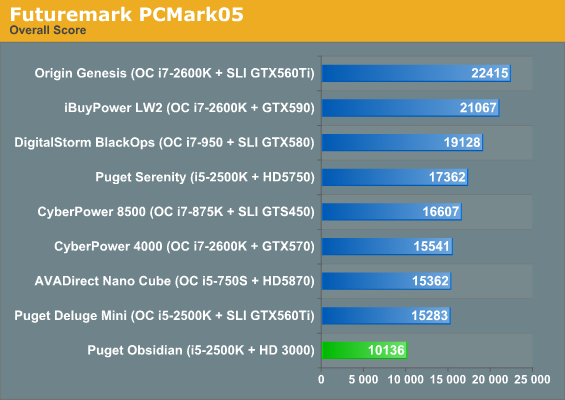
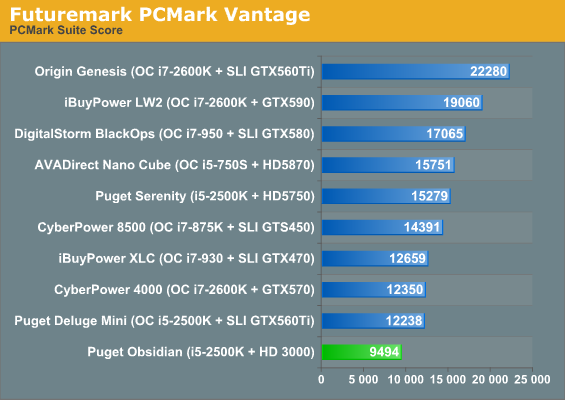
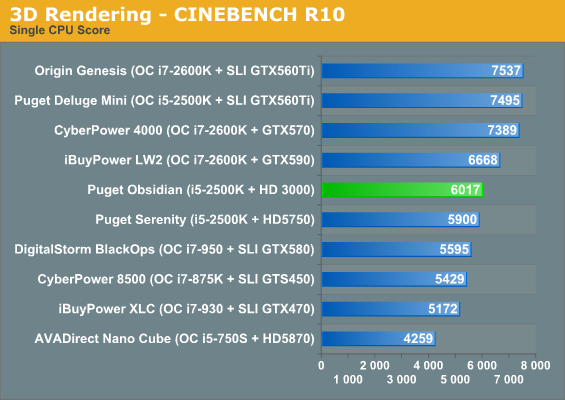

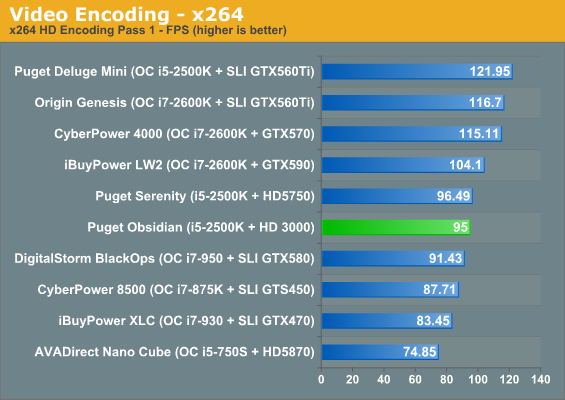

In any situation where the application can take advantage of Hyper-Threading, the i5-2500K has a tough time keeping pace. Overclocked Nehalem-class processors have a hard time keeping pace with it in less heavily threaded loads, but once Hyper-Threading kicks in they're able to gain traction. Meanwhile, PCMark continues to skew heavily towards systems with SSDs.
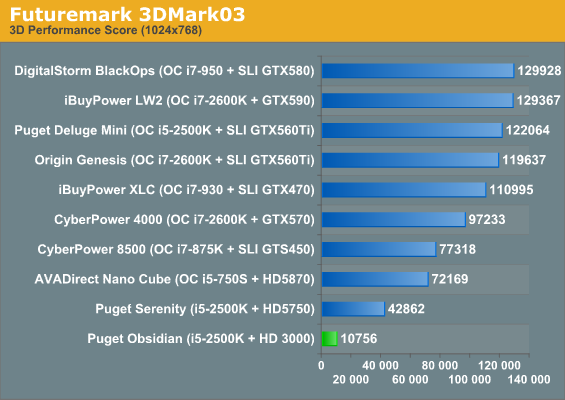
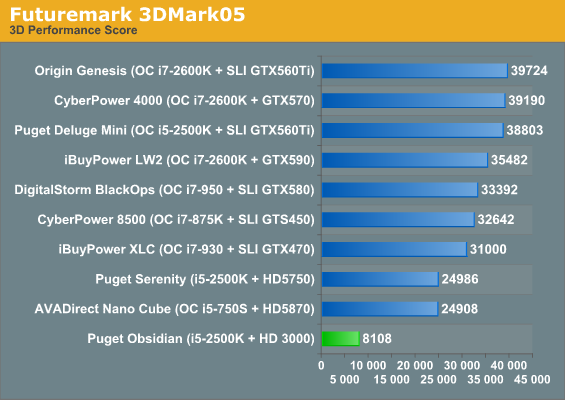
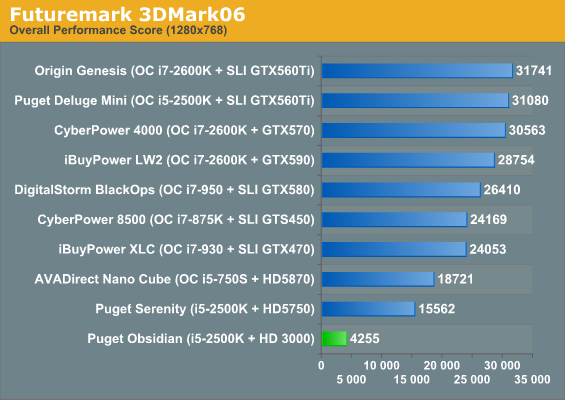
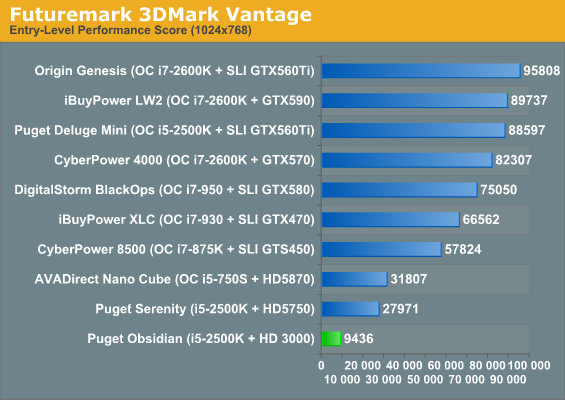
Given that the next slowest GPU on our charts is the capable AMD Radeon HD 5750, it's no surprise Intel's integrated graphics keep the Obsidian at the bottom of the pack. Anand's already gone into better detail about the HD 3000's performance than I ever could in his review of Sandy Bridge; it's not really worth running the Obsidian through our battery of gaming tests just to confirm that, no, the HD 3000 does not produce anything even remotely resembling playable performance in Metro 2033 at 1080p. I know some of you are crushed to learn that.










27 Comments
View All Comments
Dustin Sklavos - Monday, April 11, 2011 - link
We're actually working on getting enterprise-class desktops in for review right now.robbster - Monday, April 11, 2011 - link
Have had occasion to use Puget for a couple of custom builds over the years for video/animation work and CAD. Their focus on quite machines that are uber-reliable is the key, and puts them in a special niche' that is attractive to folks in large businesses who also need a custom rig. The two builds I got worked very well and lasted a long time, with the exception of the hard drives, which were subject to the same risk of failure as all mechanical drives.Net, I agree that, if you're going to go with Puget for the quality and quite, then definitely equip the Obsidian with a SSD boot and larger RAID for data (using RAID-specific drives), to which you can backup the main drive as well. This is also how I build 'em for home, works great!
7Enigma - Tuesday, April 12, 2011 - link
So basically I can build this same exact system for much less and have Puget to thank for the R&D that went into the component selection. :) sounds like a win.Seriously though, they need some form of custom design in order to justify the price hike. I don't think you can compare this build to a Dell or HP as some of those vital components are total junk, the Puget uses quality gear. But without making a real need from a custom angle (sound dampening, ducting, etc.) and the pathetic warranty I just couldn't recommend this system to someone.
Thanks for the informative review.
yehuda - Tuesday, April 12, 2011 - link
With reliability being the primary selling point I'm surprised they did not use a server board and ECC memory. Do they not mind the risk of using consumer RAM in a business critical machine? Or maybe there's no practical risk? I'm genuinely curious.bobbozzo - Tuesday, April 12, 2011 - link
I don't know about Sandy Bridge systems, but many 'enthusiast' systems I have built over the years will run with ECC memory.yehuda - Tuesday, April 12, 2011 - link
No, not since the 975X I'm afraid. None of the enthusiast or mainstream platforms that followed supported it, and I really don't know how we should approach the subject nowadays, because personally I've always worried that a system without ECC memory is inherently unstable.Seeing as this build lauds reliability so much and yet Puget found it appropriate to ship 8 gigs of non-ECC memory to a very demanding sector, I'll be happy if they could share their reasoning.
spikespiegal - Monday, April 18, 2011 - link
So, Puget slaps together enthusiast parts and suddenly they are an HP / Dell contender? Yeah...OK. When you sell a million towers then you'll have some demographics to compare with a Dell precision.Failure rates of PCs are typically caused by component failure well outside the scope of what Puget claims they are testing; bad caps, faulty ICs, nominal voltage controllers, flaky HD controllers and motors, etc.
I'm trying to find an ASUS or Antec brand component in our data center and can't.
The low power consumption was due to the weak processor and lack of a dedicated video card. We have some dual core Thin Clients that use a fraction the power of the Puget and run on flash memory - no HD either. Would you like to benchmark those?